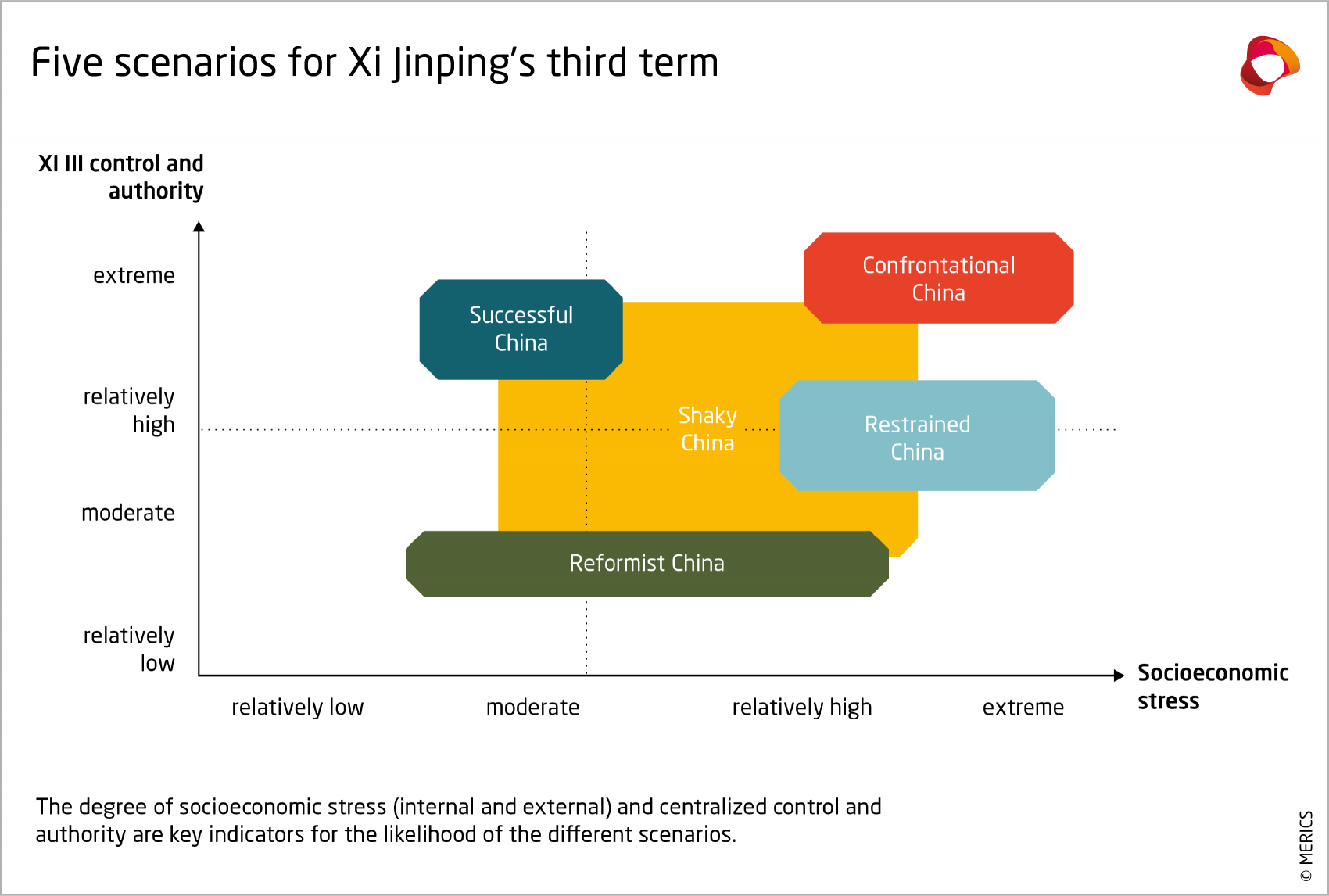

Executive summary
You are reading the Executive Summary of the report "Shaky China - Five scenarios for Xi Jinping's third term". Click here to go back to the table of contents.
In March 2023, Xi Jinping sealed a third term in power heading both the Chinese Communist Party (CCP) and the Chinese state. In “Xi III”, China is entering a phase of increasing uncertainty. Three trends that shaped China in Xi’s first and second term will remain particularly relevant: slower growth, external pressure and increased centralization of power. Whatever path China takes will have serious implications for its own people and the rest of the world.
This study lays out five scenarios for China’s path over the coming years in order to help formulate strategic responses. They were developed at Mercator Institute for China Studies (MERICS) with methodological guidance from the Fraunhofer Institute for Systems and Innovation Research (ISI) and draw on 15 political, social, economic and technological factors.
The baseline scenario is a “Shaky China”, an unstable ‘status quo’ scenario, in which China’s economy, politics and engagement with the world follow the trends seen at the outset of Xi’s third term in office. Significant changes in some of the underlying factors could create pathways to cross over into one of four more extreme scenarios:
- Confrontational China: In this scenario, tensions over Taiwan escalate to a point where the grey-zone conflict is heightened enough to make open military conflict feel increasingly likely. This generates extreme bifurcation and significant decoupling between China and the West.
- Successful China: In this scenario, China is perceived to achieve key goals in Xi’s agenda: all-encompassing party-state control, a shift to sustainable green growth, technological independence and global influence rivalling the US. Preconditions for this scenario would be a significant crisis of the West, tangible Chinese success stories and a successful power play with the Global South.
- Restrained China: In this scenario, China’s internal weaknesses, plus coalition-building by the United States and likeminded countries, hamper Beijing’s efforts to diversify the economy, maintain growth, achieve technological independence, build external coalitions or pursue an effective global power play.
- Reformist China: In this scenario, China's internal crises result in a political course correction. The confrontation between China and the West is reduced amid expectations of a return to "reform and opening up", if under new circumstances.
All scenarios are possible, but this does not mean that a scenario will be realized in full. Trajectories and perceptions of them matter. The degree of socioeconomic stress (internal and external) and centralized control and authority are key indicators of the likelihood of different scenarios. The baseline scenario “Shaky China” covers the broadest range of different levels of stress and centralization. Should socioeconomic stress rise even further, both a “Confrontational China” or a “Restrained China” become more likely. A “Successful China” becomes more realistic if the CCP were perceived to be extremely successful at mitigating socioeconomic stress. A “Reformist China” would imply significant decentralization of power and currently seems almost impossible.
European policy makers and private businesses alike need to understand the realities of a more “Shaky China” and the possibility of a shift into more extreme scenarios. The risk exposure of individual actors and opportunities associated with different scenarios vary greatly. Whatever their situation, three steps are needed:
- Analyzing opportunities and risks: In Europe, policy makers and private businesses need to find a new balance between China-related risks and opportunities. This study provides a broad overview from the perspective of European policy makers and corporates.
- Planning preparation and mitigation measures: Policy makers and private enterprises need a full-fledged portfolio of mitigation measures. In the EU, these are currently being discussed and developed around the concept of “de-risking”. To build robust strategies, actors need to consider various pathways rather than preparing for a single scenario.
- Tracking triggers: Decision makers need to closely monitor China’s development, in particular by tracking the potential triggers that could bring a change in China’s trajectory. This study offers an overview of triggers that could turn out to be significant and deserve the attention of decision makers.
You were reading the Executive Summary of the report "Shaky China - Five scenarios for Xi Jinping's third term". Click here to go back to the table of contents.

